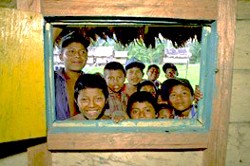
Challenge
For centuries, Indigenous Misquito and Mayangna communities lived off the land in what is now Nicaragua’s Bosawas Biosphere Reserve. For years, Nicaragua’s government did not recognize the indigenous peoples’ claim on the land. Also, since the end of the civil war in 1990, poor farmers, or mestizos, from different parts of the country migrated to Bosawas, converting natural forests to grazing lands and threatening both the integrity of the indigenous communities and the region’s biodiversity.
Initiative
USAID worked with The Nature Conservancy to support efforts to grant indigenous people titles to the lands where they live while safeguarding protected areas. The program provided legal counsel, territorial border demarcation, and training for nearly 100 voluntary forest guards. The guards enforce indigenous ecological regulations, support the region’s conservation plan, and monitor game species. The program also introduced farmer-to-farmer learning models to promote best practices for agroforestry systems between communities.
Results
Thanks partly to the program’s success, Nicaragua’s parliament passed an indigenous territories titling law in 2003. In May 2005, Nicaragua granted six land titles covering 2,531 squared kilometers to 41 indigenous communities in the Bosawas Reserve. The decision to grant communal, non-transferable property rights to indigenous people is a victory for both self-determination and forest conservation efforts. Now that the land legally belongs to the Misquito and Mayangna communities, they can apply the skills acquired through the program to managing their territories. By securing the rights of 21,000 indigenous peoples to the land they have used for centuries—as well as providing them with legal recourse to protect their territories—this historic land titling program will serve as a model for others in Nicaragua and throughout Mesoamerica.







Comment
Make a general inquiry or suggest an improvement.